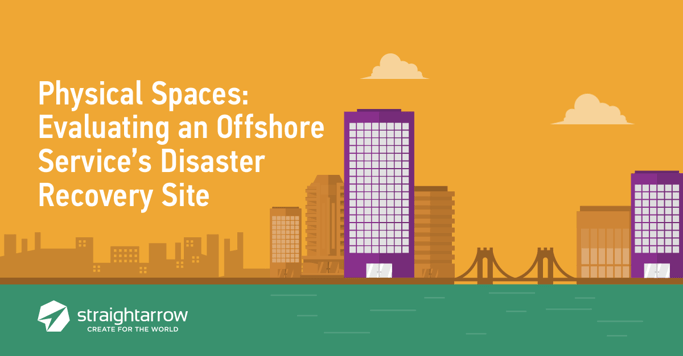
Lower costs are no longer the only way in which offshore service companies compete, but they remain one of the major factors in decisions on outsourcing. However, lower base prices —whether per hour, per person, or per project—are only one aspect in the overall consideration of managing costs. Less obvious, but equally important in determining outsourcing costs, is the management of risk.
Businesses can be put at risk by such things as extreme weather, geopolitical changes, and technological failures. While much can be done to minimize exposure to such things, they are ultimately inevitable. Thus, when choosing where to outsource your business processes, don’t simply dwell on the circumstances that put a company at risk; look at how they manage them.
Business continuity management and disaster recovery (DR) are the terms most often employed by corporations when they talk about managing risk and often get looped together. The terms aren’t interchangeable, though there is a degree of overlap. Business continuity tends to address long-term issues. While this is important, it may not affect your decision if you don’t intend, at least at the moment, to offshore your business processes in the long run. Disaster recovery, meanwhile, deals with major setbacks that could happen at any moment. It usually focuses on disasters affecting IT and data. Whether you plan to outsource long-term or short-term, you should ensure the company you contract with has sufficient DR measures.
DR often involves backups, redundant systems, and contingencies for power and telecoms. All of these ensure that if a company sustains damage to information, hardware, or even basic utilities, it will still be able to function, albeit at possibly reduced capacity. Another solution, however, is to establish a secondary site capable of running independently of the main one: a DR site.
DR sites require a significant investment of resources, but can provide significantly more security in the aftermath of a calamity. Not all DR sites are made equal, however. This is often by design, as there’s more than one way to set up and manage one. Evaluating such facilities requires some understanding of the conventional approaches to setting them up, which we discuss below.
1) Cold Sites
These spaces remain unoccupied and unused while normal operations are ongoing, but have access to power, connectivity, and other basic utilities so that they can be outfitted with equipment in the wake of a disaster.
Cold sites are less costly to maintain, given that only basic rental and upkeep costs on the space itself need be paid most of the time. On the other hand, they have a longer recovery time: fully transferring equipment and getting it running takes a matter of days or even weeks, depending on the extent of equipment and the company’s protocol.
A cold site is viable for businesses who can afford to have their processes down for a week or so in the wake of a disaster. If you require a shorter recovery time, an offshore services company with a cold site may not be your best bet. And if you can afford to have your processes down, be sure to vet their protocols for transferring equipment to their cold site—messy plans could lengthen recovery time even more.
2) Hot Sites
In contrast to cold sites, hot sites are fully equipped and kept running at all times. These facilities maintain dedicated information storage, and data from the main site is replicated in real time to keep the hot site synchronized and ready for use at a moment’s notice.
Recovery time is cut down to a matter of hours for hot sites, with the only real restriction being the speed at which personnel can reorganise themselves at the facility and resume operations.
The costs of maintaining a hot site are prohibitive, however, and so most of them are shared by multiple companies. Sometimes hot sites are provided by businesses that contract with multiple companies, relying on the improbability of multiple companies having a crisis at the same time. Because equipment is shared in such cases, it can pose a limit on the functions a hot site can provide. Be sure to look into how your business process offshoring provider maintains its hot site and if it is outsourced from a third party.
3) Warm Sites
These work like hot sites, but rely on backups rather than synchronised data. In other words, a company using a hot site would have to transfer backed-up data to the site before resuming operations, and would have to resume from the most recent backup. As storage and backup technology advances, however, the discrepancies between hot sites and warm sites shrink; recovery time is typically around a day.
Warm sites cost much less to maintain, but still often follow a shared model. As such, when vetting a warm site, bear in mind the same things you would when considering a hot site. Also be sure to examine the company’s protocols for transferring data when choosing your provider for business process outsourcing.
A final point of consideration, which bears out regardless of the type of DR site, is the distance between the main site and the DR site. While having the two in relative proximity shortens the time it takes to set up in the new facility, it is important to have them far enough apart that disasters affecting the main site are unlikely to affect the backup site. At the very least, DR sites should rely on a separate power grid and telecom grid from the main site, lest a single calamity disable both facilities at once.
Find out if you are ready to outsource your processes offshore. Download the eBook - A Practical Guide to Creative Process Outsourcing to find out more and join the thousands who have learned from something new.




Comments